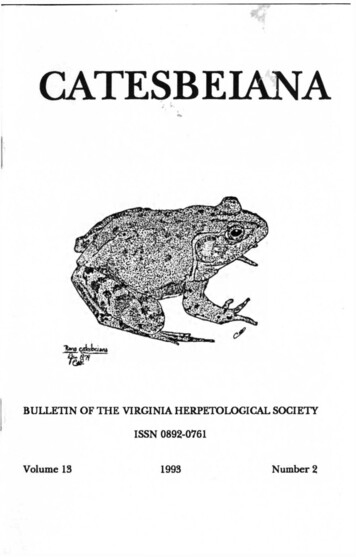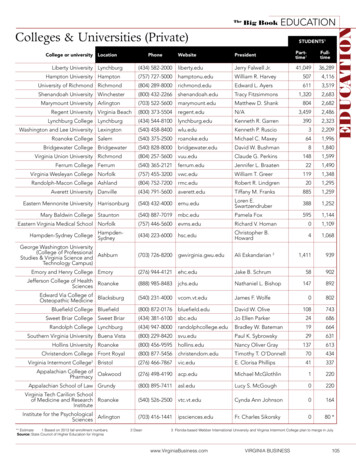
Transcription
CATESBEIANABULLETIN OF THE VIRGINIA HERPETOLOGICAL SOCIETYISSN 0892-0761Volume 131993Number 2
BULLETIN INFORMATIONCatesbeiana is issued twice a year by die Virginia HerpetologicalSociety. Membership is open to all individuals interested in die study ofamphibians and reputes and includes a subscripdon to Catesbeiana andadmission to all meedngs.Dues are 10.00 per year and includes a subscripdon toCatesbeiana numbers 1 and 2 for diat year. Dues are payable to:Ronald Soudiwick, Secretary-Treasurer, 408 Franklin Drive, Blacksburg,VA 24060.EDITORIAL POLICYThe principle funcdon of Catesbeiana is to publish observadonsand original research about Virginia herpetology. Rarely will arucles bereprinted in Catesbeiana after they have been published elsewhere. Allcorrespondence relauve to suitability of manuscripts or odier editorialconsideradons should be directed to Co-editors, Catesbeiana, Departmentof Biology, Liberty University, Box 20,000, Lynchburg, VA 24506.Major PapersManuscripts being submitted for publicadon should betypewritten (double spaced) on good quality 8Vs by 11 inch paper, widiadequate margins. Consult the style of articles in diis issue for additionalinformation. Articles will be refereed by at least one officer (past orpresent) of die Virginia Herpetological Society in addition to die editor.All changes must be approved by die audior before publicadon; diereforemanuscripts must be submitted well in advance of die March orSeptember mailing dates.Reprints of arucles are not available to audiors; however, audiors mayreprint articles diemselves to meet professional needs.(Editorial policy continued on inside back cover.)
CATESBEIANABulletin of the Virginia Herpetological SocietyVolume 13Fall 1993No. 2ContentsAn Annotated Checklist of the Amphibians andReptiles of Shenandoah National Park, VA.by William L. Witt. 26Survey of Loudon County, Virginia for the StateThreatened Wood Turde, Clemmys insculptaby Sue Bruenderman. 36Results of the 1993 VHS Spring Meeting and Field Tripby Michael Hayslett. 44Field Notes. 46The President’s Corner.48Obituary - John Thornton Wood. 51Minutes of the Spring 1993 VHS Meeting. 52Treasurer’s Report of the Spring1993 VHS Meeting. 53Fall 1993 Meeting Notice. 541993 Membership List.57MEETING NOTICEf * I)The1993 VHS meeting will be held on 9 October 1993 at LibertyUniversity in Lynchburg, VA. See page 55 for details.24
CATESBEIANA 1993, 13(2)25
ANNOTATED CHECKLIST OF THE AMPHIBIANS AND REPTILESOFSHENANDOAH NATIONAL PARK, VIRGINIAWilliam L. Witt5823 N. Washington Blvd., #80Arlington, VA 22205Within die 195,382 acre area comprising Shenandoah NationalPark diere are four turdes, four lizards, 19 snakes, 14 salamanders, and10 frogs and toads reported or expected. Much of this diversity is due todie 1137 vertical meter range along the 168 km of die Blue RidgeMountains in Virginia. Some species barely enter the Park from dieShenandoah Valley to the west or from the Piedmont to the east. Speciesrepresented range from diose diat are widespread to diose diat areseverely restricted in distribudon. One snake, the eastern garter snakeoccurs diroughout die eastern half of die country, but the Shenandoahsalamander ranges in about a dozen apparendy separate populadonsalong a 8 km stretch of die ridge between The Pinnacle and HawksbillMountain.This paper presents a review of the species known to occur inShenandoah National Park and a summary of the previously unpublishedchecklists of the park’s herpetofauna.Annotated Species ChecklistSalamandersJefferson salamander (Ambystoma jeflenonianum )Known only from Big Meadows swamp. Not reported outside ofits late winter breeding period.Spotted salamander (Ambystoma maculatum)Big Meadows, and scattered ridge top marshes.occasionally after heavy rain at lower elevadons.FoundNordiern dusky salamander (Desmognathus fuscus fuscus)Banks of streams, under rock, wood. Abundant at all elevadons.Virginia seal salamander (Desmognathus monticola jeflei'soni)Pardal to spring seeps. Moderately abundant.Catesbeiana 1993, 13(2):26-3526
CATESBEIANA 1993, 13(2)Northern two-lined salamander (Eurycea bislineata)Banks of streams under rocks, wood. Away from water insummer. Abundant at all elevations.Long-tailed salamander (Eurycea longicauda longicauda)In rock crevices, stream bank cover. White Oak Canyon, BigRun. Rare.Three-lined salamander* (Eurycea longicauda guttolineata)Occurs in all streams along east side of Park.Northern spring salamander (Gyrinophilus porphyriticus porphyriticus)In streams under rocks. Away from water in summer.Uncommon.Four-toed salamander (Hemidactylium scutatum)Known only from Big Meadows Swamp but should be in odiermarshy locations. Rare.Red-spotted newt (Notophthalmus viridescens viridescens)Efts [terrestrial larval phase] wander freely in the Park, beingseen frequendy by hikers. Adults seen in overflow pools alongBig Run. Moderately abundantRed-backed salamander (Plcthodon cinereus)Abundant, found in most forested areas of the Park.Slimy salamander (Plethodon cylindraceus)Our largest commonly seen species. Well drained forest areas.Not abundant but found at all elevations.Shenandoah salamander (Plethodon Shenandoah)This federally endangered species’entire known range consistsof about a dozen separate populations in rock slopes along a 8km stretch of die ridge between The Pinnacle and HawksbillMountain. It closely resembles die red-backed salamander.Nordiern red salamander (Pseudotriton ruber ruber)Under cover on banks of streams. Away from water in summer.Uncommon.27
SHENANDOAH NATIONAL PARK SURVEYFrogs and ToadsNorthern cricket frog (Acris crepitans crepitans)Occurs along margins of streams. Reported from Camp Hoover,Black Rock Spring, and the head of Paines Run. Uncommon.American toad (Bufo americanus americanus)Moderately common at all elevations. Seen in early evening.Fowler’s toad (Bufo woodhousii fowleri)A single report from Big Run. Rare.Eastern gray treefrog (Hyla versicolor)It is reported from Big Meadows, Skyland, Park headquartersand Simmons’ Gap ranger station.Nordiern spring peeper (Pseudacris crucifer crucifer)Breeds in the Big Meadows swamp in early spring, but its rarelyseen afterward.Upland chorus frog (Pseudacris triseriata feriarum)Breeds in Big Meadows swamp. Uncommon.Bullfrog (Rana catesbeiana)Observed in Big Meadows swamp. Big and Jerem ey’s Runs.Green frog (Rana clamitans melanota)Abundant in springs and creeks. Tadpoles reported in BigMeadows swamp, around Camp Hoover and along Big Run.Pickerel frog (Rana palustris)Occurs in springs, wet grass, banks of all water courses. Breedsin overflow pools beside all creeks. Moderately abundant.Wood frog (Rana sylvatica)This species breeds in large numbers in the Big Meadows regionin late winter yet are seldom seen afterward.28
CATESBEIANA 1993, 13(2)TurtlesSnapping turtle (Clielydra serpentina serpentina)Reported from the Big Meadows area, Panorama, and along theAppalachian Trail. This species probably does not nest in theSNP. Records are probably of transients wandering through thepark.Eastern painted turtle (Clirysemys picta picta)Occasionally observed along the Drive.Wood turde (Clemmys insculpta)Reported along Dickey ridge to Compton Gap.reports only.OccasionalEastern box turde ( Tetrapene Carolina Carolina)Only turde positively known to breed in the Park. Moderatelyabundant.LizardsNorthern coal skink (Eumeces antliracinus anthracinus )A single record is known from Sugar Hollow on Pond ridgewest of the Charlottesville Reservoir in Albemarle County.Five-lined skink (Eumeces fasciatus)Reported from Camp Hoover and Old Rag Mountain. Rare.Northern fence lizard (Sceloporus undulatus hyacintliinus)May be found sunning on open rock feces and dead timber atlower elevations. It is moderately abundant in some areas.Ground skink (Scincella lateralis)Reported by Stafi/visitor in July 1979 from Hightop Mountain.SnakesEastern worm snake (Carpliopliis amoenus amoenus)An uncommon burrowing snake found in and under logs androcks. Reported from Camp Hoover and along Big Run.29
SHENANDOAH NATIONAL PARK SURVEYNorthern black racer (Coluber constrictor constrictor)A snake of forest edges and forest clearings. Occurs at allelevations widi favorable habitat. Reports from Big Meadowsand along U.S. Route 211 in Thornton gap among others. Itis not abundantNorthern ringneck snake (Diadophis punctatus edwardsii)This is the most common snake in the SNP. Look for it underrocks on sunny hillsides.Corn snake (Elaphe guttata guttata)Scattered reports along Skyline Drive. Easily mistaken forsmall eastern milk snakes (Lampropcltis triangulutn). It isuncommon.Black rat snake {Elaphe obsoleta obsoleta)Frequently seen along the Skyline Drive. It is also found instanding timber and occurs at all elevadons.Eastern hognose snake (Heterodon pladrhinos)Burrows in loose soil and sand. Rare.Eastern king snake {Lampropcltis getula getula)Scattered reports along Skyline Drive. Uncommon.Eastern milk snake {Lampropeltis triangulum triangulum)Our most abundant king snake. Mistaken for Corn snakes.Reported from all elevadons.Northern water snake {Nerodia sipedon sipedon)Seldom found far from water. Reported from an elevauon of833 meters and below. Not abundant.Rough green snake {Opheodrys aestivus)Lives among die leaves of bushes and vines. Reported from1200 meters at Skyland down to Park Headquarters.Uncommon.Smoodi green snake {Opheodrys vernalis vcrnalis)Hides under deep set rocks. Frequendy seen in die Big30
CATESBEIANA 1993, 13(2)Meadows area. Scattered reportes further soudi, but nonenorth.Northern pine snake (Picuophis melanoleucus melanoleucus)A single record of this snake from Jarm an Gap. Scatteredreports along die west side of die south secdon and alongSkyline Drive. Rare.Queen snake (Regina septemvittata)Reported from Pass run opposite Park Headquarters andalong Big Creek just at the western boundary.Northern red-bellied snake (Storeria occipitomaculataoccipitomaculata)Frequendy reported from Big Meadows and Limberlost areaof White Oak Canyon.Eastern ribbon snake (Thamnophis sauritus sauritus)Ribbon snakes occur close to water. Observed from BigMeadows to the lowest reaches of Big Run.Eastern garter snake (Thamnophis sirtalis sirtalis)Garter snakes are moderately abundant at all elevations. Lookfor diem along the edges o f open grassy areas, such as BigMeadows.Smooth earth snake ( Virginia valeriac valeriac)Reported from Barry Hollow just east of die SNP boundaryNorthern copperhead (Agkistrodon contortrix mokasen)Copperheads are found at all elevations but are mostnumerous in humid forests below 833 meters. Becominguncommon in recent years.Timber ratdesnake (Crotalus horrid us)Our largest poisonous snakes, but less often encountered.Partial to drier rocky areas, and most active at dusk into earlyevening. Increasingly uncommon.31
SHENANDOAH NATIONAL PARK SURVEYHistorical Summary of Herpetofeunal ChecklistsThe first extant checklists of the amphibians and reptiles of theShenandoah National Park were developed by W. Drew Chick, whowas the acting park naturalist 1936-1943. They were both finalized on22 November 1944. There were apparendy two original lists, one onamphibians and one on reptiles, as indicated by the term "Revised" ineach of Drew’s lists. However, these have not been located and arepresumed lost Paul Favour, who was the chief naturalist in the parkfollowing Chick, revised the checklists on 24 April 1951. Witt (1971)further revised diese checklists and updated the taxonomy. Shelton(1975) used diis version in his natural history book on the ShenandoahNadonal Park. Witt (1992) again updated the 1971 checklist for thepark service. A comparison of these checklists (Table 1) shows thedevelopment of die amphibian and repdle species lists since about1940. Future research on die distributions and taxonomy of theseanimals will produce addidonal changes in later revisions of these lists.Table 1. Historical summary of the herpetofauna of ShenandoahNadonal Park as viewed by a sequence of mosdy unpublishedchecklists. Legend: (1) Chick, 1944a, 1944b, (2) Favour, 1951a, 1951b,(3) Shelton, 1975, (4) Witt, 1971, 1992.SpeciesI234?##### ########?## Salamanders:Ambystoma jeffersonianumAmbystoma maculatumAmbystoma opacumAmbystoma L dgrinumDesmognathus f. fuscusDesmognathus nionucola jefTersoniDesmognadius ochrophaeusEurycea bislineataEurycea 1. longicaudaEurycea 1. guttolineataGyrinophilus p. porphyridcus32 ###?########
CATESBEIANA 1993, 13(2)Hemidactylium scuta turnNotophthalmus v. viridescensPlethodon c. cinereusPlethodon cylindraceusPlethodon shenandoahPseudotriton r. ruberPseudotriton r. niticus%###%#%###%#######?########## ######%####Frogs and Toads:Acris c. crepitansBufo a. americanusBufo woodhousii fowleriHyla v. versicolorPseudacris brachyphonaPseudacris c. cruciferPseudacris triseriata feriarumRana catesbeianaRana clamitans melanotaRana palustrisRana sylvaticaScaphiopus h. ###%Turtles:Chelydra s. serpentinaChrysemys p. pictaClemmys guttataClemmys insculptaSternotherus odoratusTerrapene c. Carolina## # #####Lizards:Eumeces a. anthracinusEuineces fasciatusEumeces inexpectatusEumeces laticepsSceloporus undulatus hyacindiinusScincella lateralis33## ####%*
SHENANDOAH NATIONAL PARK SURVEYSnakes:Agkistrodon contortrix mokasenCarphophis a. amoenusCemophora coccinea copeiColuber c. constrictorCrotalus h. horridusDiadophis punctatus edwardsiiElaphe g. guttataElaphe o. obsoletaHeterodon platirhinosLampropeltis c. calligasterLampropelds g. getulaLampropeltis t triangulumNerodia s. sipedonOpheodrys aesuvusOpheodrys v. vernalisPituophis m. melanoleucusRegina septemvittataStoreria d. dekayiStoreria o. occipitomaculataTandlla coronataThamnophis s. sauritusThamnophis s. sirtalisVirginia v. valeriae#%#######%######%###%##?%####%###?%%##### ###### ########?# ## ############### ### # presence confirmed* tentatively identified? doubtful identification [my opinion of die checklist entry]% new or unreported species [not known to some audiors]v voice record [frogs and toads] possible species; known to occur near border (Witt, 1971; Sheldon,1975)AcknowledgmentsI am grateful to die Shenandoah National Park staff fornumerous courtesies and for permission to study amphibians andreptiles in die park over many years. Joseph C. Mitchell produced thefinal version of diis paper.34
CATESBEIANA 1993, 13(2)Literature CitedChick, W. D. 1944a. Revised list of amphibians in the ShenandoahNational Park, Virginia. Unpublished report in Shenandoah NationalPark files, Luray, VA. 4 pp.Chick, W. D. 1944b. Revised list of reptiles in die ShenandoahNadonal Park, Virginia. Unpublished report in Shenandoah NationalPark files, Luray, VA. 5 pp.Favour, P. 1951a. Revised list of amphibians in die ShenandoahNadonal Park, Virginia. Unpublished report in Shenandoah NadonalPark files, Luray, VA. 2 pp.Favour, P. 1951b. Revised list of repdles in the Shenandoah NadonalPark, Virginia. Unpublished report in Shenandoah Nadonal Park files,Luray, VA. 2 pp.Shelton, N. 1975. The Nature of Shenandoah. Natural History Series,Nadonal Park Service, U.S. Dept of the Interior, Washington, D.C.113 pp.Witt, W. L. 1971. Checklist of the amphibians and reptiles ofShenandoah Nadonal Park. Unpublished report to ShenandoahNadonal Park, Luray, VA. 4 pp.Witt. W. L. 1992. Checklist of the amphibians and repdles ofShenandoah Nadonal Park. Unpublished report to ShenandoahNadonal Park, Luray, VA. 4 pp.35
SURVEY OF LOUDON COUNTY, VIRGINIAFOR THE STATE THREATENEDWOOD TURTLE, CLEMMYS INSCULPTASue A. BruendermanVirginia Department of Game and Inland Fisheries2206 South Main Street, Suite CBlacksburg, Virginia 24060The Virginia Herpetological Society’s 16-17 April, 1993 spring meetingprovided VHS members and others with a unique opportunity to assistthe Virginia Department of Game and Inland Fisheries in efforts toprotect and conserve one of Virginia’s rarest reptile species. High levelsof turbidity and increased stream velocities from storm events the weekprior to the survey precluded die discovery of our target species, the stateendangered wood turde, Clemmys insculpta. Nevertheless, participantsidentified potential habitat, as well as unsuitable habitats, of the woodturde in Loudon County, thereby reducing area and search requirementsneeded for diis species in future surveys in this county. Results of thesurvey also increased our knowledge of the herpetofeuna of LoudonCounty, having documented the occurrence of numerous species ofamphibians, reptiles, and other animals.Wood turtles hibernate in aquatic environments during fell and wintermonths and in Virginia and are known to begin emerging from clearbrooks and streams during the month of April (Ernst 1986). Therefore,we chose mid-April to conduct our survey. The rationale was that thelikelihood of success in finding these rare animals would be increasedduring diis time, as they would be relatively confined in the streamenvironment, are easy to visually locate from the stream bank in theclear water which they seem to prefer (pers. observ.), and would have ju stbegun to move about, basking on logs, and perhaps even foraging aboutwithin riparian areas of streams. During later months of spring, summer,and even early fall, these animals are known to travel extensively on landin search of food and nest sites, thus decreasing chances of finding them.Nine sub-watersheds of die Potomac River Basin were pre-selected forsurvey efforts widi input from a wood turde expert (John McBreen, pers.comm.), and odier biologists familiar widi bodi die drainage and diebiology of die species (Phil Stevenson, and Kurt Bulilmann, pers. comm.).Cacesbeiana 1993, 13(2):36-4336
CA TESBEIANA 1993, 13(2)MethodsOn 17 April, 1993, instream habitat and riparian areas were searchedwithin reaches of eleven tributaries of the Potomac River in LoudonCounty. Where possible during stream investigations, long-handled dipnets were used to probe and search logjams, woody debris, overhangingroot systems and banks, muskrat burrows and any other instream habitatencountered. Because wood turdes in odier parts of their range inhabitmarshy fields and woodland bogs, and are known to wander extensivelyon land in search of food and appropriate nesting sites, riparian areasadjacent to targeted streams also were searched. Riparian habitats diatwere investigated included small pools and tributaries, moist areas, andany understory vegetation which potentially could conceal a wood turtle.Nine survey teams ranged in size from 2 to 9 persons; average team sizewas six individuals. Except for one 15 minute search which endedprematurely due to steep terrain and absence of a floodplain, search timeper team/per site ranged from 0.5 to 3 hours, with an average of 1.6hours. Water temperatures ranged from 12-14 C; weather was partlycloudy, breezy and cool (air temperature roughly 16 C).ResultsTo follow is a list, by stream, of the herpetofauna and other animalsobserved and subsequently released by survey participants at 19 samplingstations within the Potomac River Basin. Sites that contained habitatconditions suitable for wood turtles, which warrant further investigationfor the potential occurrence of this state threatened species, are labeled"high". Area covered per survey site (longitudinal stream length) isindicated in parentheses. Area of floodplain habitats that were searchedvaried between groups and sites, were not recorded consistently and thusare not reported here. Sites labeled "low" were considered to be of poorquality and should not be revisited during the next survey for woodturtles in Loudon County, Virginia. "Moderate" sites should be visited iftime, funding, and personnel allow; priority, however, should be givento targeting other unexplored, potentially high quality areas in LoudonCounty.37
WOOD TURTLE SURVEY OF LOUDON COUNTYPincv Run - from R l 686 bridge crossing and upstream for 0.8 km( 0.8 km distance; Harper’s Ferry 7.5’ quad). Search effort: 5 persons,1.5 hr per person. Potential for wood turtles: high.snapping turde (Chelydra serpentina) juvenilepainted turde (Chrysemys picta) male, crossing roadbox turde (Terrapene Carolina)live individual plus pardalplastronPinev Run - headwaters at R l 687 crossing ( 500 m distance; HarperFerry’s 7.5’quad). Search effort: 5 persons, 0.5 hr per person. Potentialfor wood turtles: low.Redback salamander (Plethodon cinereus)slimy salamaner (Plethodon cylindraceus)Dutchman Creek - R l 674 crossing, near mouth and upstream fromconfluence widi Potomac River ( 200 m distance; Harper’s Ferry 7.5’quad). Search effort: 8 persons, 2 hr per person. Potential for woodturtles: high.eastern ribbon snake (Thamnophis sauritus)redback salamander (Plethodon cinereus)redbelly turde (Pseudemys rubriventris) juvenilenorthern two-lined salamander (Eurycea bislineata)beaverSugarland Run - 0.8 km. N. of Co. RL 1208 (Thomas Ave.) crossing, .8 km north of Herndon Junction ( 0.8 km distance; Seneca MD-VA7.5’quad) Note: this reach was severely impacted by recent diesel oil spill(Colonial Pipeline, 29 March, 1993, at Reston, VA). Floodplain treespecies: sycamore, river birch, sweetgum. Herbaceous cover was flooded(diesel fuel still a major component of water column, as judged by strongdiesel odor). Rocks along several bank areas were checked for signs ofanimal life; 2 earthworms were the only live animals found in 0.8 kmreach surveyed. Search effort: 7 persons, 1.25 hr per person. Potential forwood turtle habitat: low.dead crayfishAsiatic clam (dead valves only)raccoon and deer tracks observedearth worms (n 2)38
CATESBEIANA 1993, 13(2)North Fork Catoctin Creek - at R t 690 bridge crossing, southeast ofHillsboro, downstream for 1.5 km ( 1 km distance; Purcellville 7.5’quad). Search effort: 7 persons, 1.5 hr per person. Potential for woodturtle habitat: high. Flagging observed indicative of potential encroachingdevelopmentredback salamander (Pletliodon cinereus) lead and red varietiesspotted salamander (Ambystoma maculatum) live & dead eggspickerel frog (Rana palustiis)eastern garter snake (Thamnophis sirtalis) n 3eastern box turtle (Terrapene Carolina)North Fork Catoctin Creek - at R t 752 crossing, upstream to Rt 287bridge crossing ( 2.5 km distance; Purcellville 7.5’ quad). Search effort:7 persons, 1.25 hr per person. Pbtcntial for wood turtles: highspring peeper (Pseudacris crucifer)black rat snake (Elaphe obsolcta) 1.5’long, missing an eyeeastern garter snake (Thamnophis sirtalis)pickerel frog (Rana palustris)redback salamander (Pletliodon cinereus) lead variety; abundantLittle River - from Rt. 776 crossing (2 km sw of Middleburg) downstreamto 0.3 river km downstream of Facquier/Loudon Co. line ( 1.5 kmdistance; Middleburg 7.5’quad). Search effort: 7 persons, 3 hr per person.Potential for wood turtles: high.eastern garter snake (Thamnophis sirtalis)queen snake (Regina septemvittata)pickerel frog (Rana palustris)green frog (Rana da m i tans)spring peeper (Pseudacris crucifer)eastern ellipdo (freshwater mussel)Atlantic spike (freshwater mussel)Beaverdam Creek - From RL 630/790 intersection downstream to RL 790bridge crossing ( 0.8 km distance; Bluemount, VA 7.5’quad). Searcheffort: 2 persons, 2 hr per person. Potential for wood turtles: high,green frog (Rana clamitans)box turtle (Tenapene caiolina)water snake (Nerodia sipedon)pickerel frog (Rana palustris)39
WOOD TURTLE SURVEY OF LOUDON COUNTYspotted salamander (Ambystoma maculacum) eggs in floodplainpoolwood frog tadpoles (Rana sylvauca)painted or spotted turtle (i.d. uncertain)Beaverdam Creek - R l 623 crossing, 0.8 km soudi of Howardsville( 0.8 km distance; Bluemount 7.5’ quad). Search effort: 2 persons, 1 hrper person. Potential for wood turtles: moderate, but note: local fannerclaimed "having seen a few wood turtles from time to time",green frog (Rana da micans)Beaverdam Creek - just downstream from Rt- 626 crossing, 0.8 kmsoutheast of Unison ( 1.5 km distance; Bluemount 7.5' quad). Searcheffort: 2 persons, 1.5 hr per person. Potential for wood turtles: high,green frog (Rana damitans)box turtle ( Terrapene Carolina)S.F. Catoctin Creek - R l 698 crossing at Waterford ( 1.5 km distance;Waterford 7.5’ quad). Search effort: 7 persons, 1 hr per person. Potentialfor wood turtles: high.american toad (Bufo americanus) DORCatoctin Creek - 200 m west of R l 15 bridge over Potomac River, atPoint of Rocks ( 1.5 km distance; Point of Rocks 7.5’ quad). Searcheffort: 7 persons, 2.5 hr per person. Potential for wood turtles: moderatenorthern water snake (Nerodia sipedon)redback salamander (Pletliodon cinereus)Potomac River - immediately downstream from U.S. 15 bridge at Pointof Rocks ( 0.8 km distance; Point of Rocks 7.5’ quad). Search effort: 7persons, 1 hr per person. Potential for wood turtles: moderate,redback salamander (Pletliodon cinereus)northern two-lined salamander (Eurycea bislineata)american toad (Bufo americanus)Potomac River - south bank of river from Algonquin Regional Park westto unnamed tributary of Potomac River ( 1.5 km distance; Sterling VAMD 7.5’quad). Search effort: 7 persons, 2 hr per person. Potential forwood turtles: low (however, unnamed tributary to Potomac River: high),redback salamander (Pletliodon cinereus) n 13marbled salamander {Ambystoma opacum) n l40
CATESBEIANA 1993, 13(2)northern brown snake (Storeria dekayi) DOR in park; n leastern garter snake (Thamnophis sirtalis) n lpickerel frog (Rana palustris)green frog tadpole (Rana clamitans)spotted salamander (Ambystoma maculatum) in floodplain poolNorth Fork Goose Creek - RL 611 stream crossing and extendingdownstream for 0.8 km ( 0.8 km distance; Lincoln 7.5’ quad). Searcheffort: 7 persons, 3 hr per person. Potential for wood turtles:moderate.eastern garter snake (Thamnophis sirtalis)Nerodia sp.North Fork Goose Creek - from confluence with Goose Creek, upstreamto 1.2 km above confluence with Crooked Run (4.5 km distance;Lincoln 7.5’ quad). Search effort: 5 persons, 1 hr per person. Potential forwood turtles: high.green frog (Rana clamitans) n 3redback salamander (Plethodon cinercus) n 33 spring peeper(Pscudacris crucifer)box turde (Terrapene Carolina) carpaces only; n 3Goose Creek - 0.3 km east of Rt.733/763 intersection, just upstream ofunnamed tributary at Marble Quarry Road (old ford); surveyed rightascending bank only (survey terminated prematurely because steepslopes and lack of floodplain precluded further progress; Lincoln 7.5’quad). Search effort: 5 persons, 15 min per person. Potential for woodturtles: low.no animal observations reportedGoose Creek - from confluence with N.F. Goose Creek upstream tointermittent tributary ( 1.2 km distance; Lincoln 7.5’ quad). Searcheffort: 5 persons, 0.5 hr per person. Potential for wood tuitles: high,no animal observations reportedMilltown Creek - R l 691 crossing, 1.5 km west of Rl 287, 1st house onright after beaver dam swamp ( 100 m distance; Purcellville 7.5’ quad).Search effort: 8 persons, 1 hr per person. Potential for wood turtles:moderate.no animal observations reported41
WOOD TURTLE SURVEY OF LOUDON COUNTYComments and RecommendationsWater levels were approximately 2-3 m above normal on the survey date,and as judged by fresh floodplain debris observed, many streamsexceeded full-bank just prior to the survey. The number of animalsobserved and recorded at each of the sites surveyed is not a validindicator, by itself, of die potential presence or absence of wood turtles.Observed physical condiuon of habitats, and existing level of commercialand/or residential development and other threats, weighed heavily injudging whedier survey sites had die potential to support wood turdepopulations.Because the VHS meeting dates, accommodations, etc. were fixed, we didnot have the luxury of postponing our survey. As was made obviousduring our survey attempt, good weather conditions are crucial forachieving success in attempts to find wood turtles. The benefits of havinga large group of energetic volunteer surveyors (many eyes, great effort,opportunity to educate many people about rare animals) must be weighedagainst the inflexibility diat is associated with employing such a method(inability to postpone survey).It is the opinion of die author that, for reasons stated previously, midApril is an appropriate time to conduct a survey for wood turtles inLoudon County. However, stream conditions during this time of highdischarge are subject to rapid fluctuations. An alternative sampling timewhich could be chosen is in the fell, when water levels typically are low,more predictable, and when mating activities o f the wood turtle areoccurring (Ernst and McBreen 1991). In addition, alternative samplingmediods should be considered in addition to or potentially inreplacement of, those used during this survey. Snorkeling techniques instream environments has been shown to be an effective method forfinding rare stream fishes and mollusks (Ensign etal., pers. observ.), andmay be suitable for wood turtle surveys as well.42
CA TESBEIANA 1993, 13(2)AcknowledgementsMany thanks to the VHS and especially to survey team members:Pinev Run R. Southwick, D. Mackler, P. Poore, B. Hawley, S.Bruenderm
SHENANDOAH NATIONAL PARK SURVEY Historical Summary of Herpetofeunal Checklists The first extant checklists of the amphibians and reptiles of the Shenandoah National Park were developed by W. Drew Chick, who was the acting park naturalist 1936-1943. They were both finalized on 22 Novem










